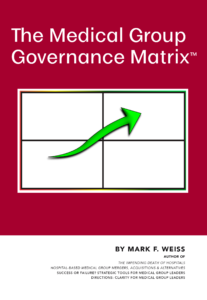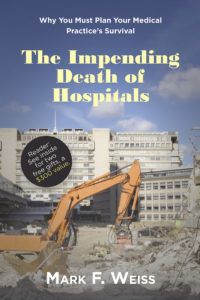Sometimes, I think it’s Groundhog Day. No, not the Punxsutawney Phil kind, but the Bill Murray movie kind, you know, when things keep repeating themselves over and over and over again. Like stupid kickback schemes.
Even so, I’m not tired writing about them because, obviously, if physicians keep doing this crap, there’s a real need for what really amounts to a public service announcement.
So, let’s start with my recommendation that you keep two things in mind:
First is a shorthand definition of the federal Anti-Kickback Statute (“AKS”), a criminal law. It prohibits offering, paying, soliciting, or receiving remuneration to induce referrals of items or services covered by Medicare and other federally funded programs. Remuneration is a broad concept – it can be made directly or indirectly, overtly or covertly, in cash or in kind.
Second, are a few lines from the epic poem Marmion by Sir Walter Scott:
Oh, what a tangled web we weave
when first we practice to deceive!
In fact, if every physician simply remembered those two points, the Department of Justice would probably have to lay off a few hundred lawyers. (Just think of the joy that would bring you.)
Let’s illustrate the importance of those two points by way of the story of New York physician, Klaus Peter Rentrop, M.D., who perhaps didn’t read about the AKS and who perhaps skipped taking an English literature class.
In mid-September 2023, the U.S. Attorney’s Office for the Southern District of New York announced that it settled a civil fraud lawsuit against Dr. Rentrop. and his medical practice Gramercy Cardiac Diagnostic Services P.C. (“Gramercy Cardiac”) for paying millions of dollars in kickbacks to physicians and their practices for patient referrals.
In connection with the settlement, Dr. Rentrop and Gramercy Cardiac admitted:
- From 2010 through 2021, Gramercy Cardiac, at Dr. Rentrop’s direction, entered into rental agreements (the “Rental Agreements”) with more than 130 physicians and medical practices (the “Rental Practices”) under which Gramercy Cardiac leased a portion of the other practice’s office space, usually one or two exam rooms for certain days or hours each month. Gramercy Cardiac paid a total of more than $11 million to the Rental Practices pursuant to the Rental Agreements.
- From 2010 through 2021, Gramercy Cardiac, at Dr. Rentrop’s direction, entered into independent contractor agreements (the “Independent Contractor Agreements”) with more than 50 cardiologists (the “Gramercy-Contracted Cardiologists”) or their medical practices.
- Gramercy Cardiac sent the Gramercy-Contracted Cardiologists to the rented office space one or more times each month to see patients who were referred for an assessment by the healthcare providers at the Rental Practice. The Gramercy-Contracted Cardiologists in turn referred these patients to Gramercy Cardiac to undergo diagnostic tests and procedures, such as PET and SPECT scans.
- Gramercy Cardiac paid many of the Gramercy-Contracted Cardiologists a flat fee for each diagnostic test or procedure which the cardiologist referred to Gramercy Cardiac provided that the patient received the test or procedure at a Gramercy Cardiac location. These “per procedure” fees were the only compensation Gramercy Cardiac provided to the Gramercy-Contracted Cardiologists.
- Certain versions of Independent Contractor Agreements stated that the Gramercy-Contracted Cardiologist was to be paid not for the referrals to Gramercy Cardiac, but rather for the “[a]dministration and supervision” of the PET and SPECT scans to be performed at Gramercy Cardiac. However, in many cases, the Gramercy-Contracted Cardiologists did not, in fact, administer and supervise the PET and SPECT scans and were nonetheless paid by Gramercy Cardiac based solely on the number of tests and procedures referred.
- At the time the Rental Agreements were executed, it was understood that the Rental Practices would refer their patients to the Gramercy-Contracted Cardiologists. Indeed, Gramercy Cardiac calculated the number of hours per month that Gramercy Cardiac leased the office space based on the volume of expected patient referrals.
- Gramercy Cardiac calculated its return on investment from its Rental Agreements — which it internally referred to as the “efficiency” of the Rental Agreements — by comparing the revenue Gramercy Cardiac generated from the patient referrals to the payments it made to the Rental Practice.
- When a Rental Agreement’s return on investment fell below the minimum threshold, Gramercy Cardiac, at Dr. Rentrop’s direction, would often refuse to pay the Rental Practice the amounts due under the Rental Agreement. In addition, at Dr. Rentrop’s direction, Gramercy Cardiac physician liaisons advised Rental Practice physicians that if the volume of referrals to Gramercy-Contracted Cardiologists did not increase, rent would be decreased, or the Rental Agreement would be terminated. Gramercy Cardiac terminated a number of Rental Agreements because the return on investment through patient referrals was too low.
- When negotiating or re-negotiating the monthly rental payment to be made under a Rental Agreement, Gramercy Cardiac took into account the expected or historic return on investment based on the volume of patient referrals generated from the Rental Practice.
- The rental fees paid by Gramercy Cardiac under the Rental Agreements were in excess of fair market value for at least some Rental Agreements.
And what will the settlement cost Dr. Rentrop and his practice?
- They’ll pay $4,510,678 to the United States government and, in regard to state claims, $1,989,362 to the State of New York, for a total of $6.5 million.
- As a form of security for the payments, Dr. Rentrop and Gramercy Cardiac entered into a Consent Judgment in the amount of $64,416,515, which may be enforced if they do not pay the required $6.5 million.
- Dr. Rentrop agreed to relinquish his ownership and control over Gramercy Cardiac by the end of 2023, and will pay a portion of the proceeds of any sale of the practice to the United States.
- He’s also indefinitely barred from working for any entity that bills federal healthcare programs, and has entered into a Voluntary Exclusion Agreement with HHS-OIG which prohibits him from, among other things, participating in Medicare, Medicaid, or other federal healthcare programs for five years.
Here’s an easy way of remembering what it appears Dr. Rentrop didn’t get. Don’t wait! Print out the following in credit card size and keep it in your wallet for frequent and easy reference:





